Neofunctionalization of Glycolytic Enzymes: An Evolutionary Route to Plant Parasitism in the Oomycete Phytophthora nicotianae
Abstract
:1. Introduction
2. Materials and Methods
2.1. Microbial Strains and Culture Conditions
2.2. Plant Material and Infection Assays
2.3. Detection of Hexose Kinase Activities
2.4. Sequence Manipulations and Phylogenetic Analyses
2.5. RNA Isolation and Transcriptional Analyses
3. Results
3.1. Phytophthora—Specific Amplification of Glucokinase Genes among Oomycetes
3.2. Different Evolutionary Histories Shaped the P. nicotianae GK Subclasses
3.3. P. nicotianae GKs Are Substrate-Specific Enzymes with Distinct Properties
3.4. Phytophthora GKs Have an Ancient Origin
3.5. Transcriptional Profiles Support Neofunctionalization of GK Genes along P. nicotianae Life Cycle
4. Discussion
Supplementary Materials
Author Contributions
Funding
Institutional Review Board Statement
Informed Consent Statement
Data Availability Statement
Acknowledgments
Conflicts of Interest
References
- Kamoun, S.; Furzer, O.; Jones, J.D.G.; Judelson, H.S.; Ali, G.S.; Dalio, R.J.D.; Roy, S.G.; Schena, L.; Zambounis, A.; Panabières, F.; et al. The Top 10 oomycete pathogens in molecular plant pathology. Mol. Plant Pathol. 2015, 16, 413–434. [Google Scholar] [CrossRef] [PubMed]
- Adl, S.M.; Bass, D.; Lane, C.E.; Lukeš, J.; Schoch, C.L.; Smirnov, A.; Agatha, S.; Berney, C.; Brown, M.W.; Burki, F.; et al. Revisions to the classification, nomenclature, and diversity of eukaryotes. J. Eukaryot. Microbiol. 2019, 66, 4–119. [Google Scholar] [CrossRef] [PubMed] [Green Version]
- Burki, F.; Roger, A.J.; Brown, M.W.; Simpson, A.G.B. The new tree of eukaryotes. Trends Ecol. Evol. 2020, 35, 43–55. [Google Scholar] [CrossRef] [PubMed] [Green Version]
- Thines, M. Phylogeny and evolution of plant pathogenic oomycetes—A global overview. Eur. J. Plant Pathol. 2014, 138, 431–447. [Google Scholar] [CrossRef]
- McGowan, J.; Fitzpatrick, D.A. Recent Advances in Oomycete Genomics, 1st ed.; Elsevier Inc.: Amsterdam, The Netherlands, 2020; Volume 105, ISBN 9780128216859. [Google Scholar]
- Thines, M.; Choi, Y.J. Evolution, diversity, and taxonomy of the Peronosporaceae, with focus on the genus Peronospora. Phytopathology 2016, 106, 6–18. [Google Scholar] [CrossRef] [Green Version]
- Bennet, R.M.; de Cock, A.W.A.M.; Levesque, C.A.; Thines, M. Calycofera gen. nov., an estuarine sister taxon to Phytopythium, Peronosporaceae. Mycol Prog. 2017, 16, 947–954. [Google Scholar] [CrossRef]
- Bennett, R.M.; Thines, M. Revisiting Salisapiliaceae. Fungal Syst. Evol. 2019, 3, 171–184. [Google Scholar] [CrossRef]
- de Cock, A.W.A.M.; Lodhi, A.M.; Rintoul, T.L.; Bala, K.; Robideau, G.P.; Gloria Abad, Z.; Coffey, M.D.; Shahzad, S.; Lévesque, C.A. Phytopythium: Molecular phylogeny and systematics. Pers. Mol. Phylogeny Evol. Fungi 2015, 34, 25–39. [Google Scholar] [CrossRef] [Green Version]
- Nam, B.; Choi, Y.J. Phytopythium and Pythium Species (Oomycota) isolated from freshwater environments of Korea. Mycobiology 2019, 47, 261–272. [Google Scholar] [CrossRef] [Green Version]
- Bourret, T.B.; Choudhury, R.A.; Mehl, H.K.; Blomquist, C.L.; McRoberts, N.; Rizzo, D.M. Multiple origins of downy mildews and mito-nuclear discordance within the paraphyletic genus Phytophthora. PLoS ONE 2018, 13, e0192502. [Google Scholar] [CrossRef] [Green Version]
- Ho, H.H.; Jong, S.C. Halophytophthora gen. nov., a new member of the family Pythiaceae. Mycotaxon 1990, 36, 659–662. [Google Scholar]
- Jung, T.; Scanu, B.; Bakonyi, J.; Seress, D.; Kovacs, G.M.; Duran, A.; von Stowasser, E.S.; Schena, L.; Mosca, S.; Thu, P.Q.; et al. Nothophytophthora gen. nov., a new sister genus of Phytophthora from natural and semi-natural ecosystems. Persoonia 2017, 39, 143–174. [Google Scholar] [CrossRef] [PubMed] [Green Version]
- Mccarthy, C.G.P.; Fitzpatrick, D.A. Phylogenomic reconstruction of the oomycete phylogeny derived from 37 genomes. mSphere 2017, 2, e00095-17. [Google Scholar] [CrossRef] [PubMed] [Green Version]
- Erwin, D.C.; Ribeiro, O.K. Phytophthora Diseases Worldwide; APS Press: St. Paul, MN, USA, 1996. [Google Scholar]
- Ah-Fong, A.M.V.; Kim, K.S.; Judelson, H.S. RNA-seq of life stages of the oomycete Phytophthora infestans reveals dynamic changes in metabolic, signal transduction, and pathogenesis genes and a major role for calcium signaling in development. BMC Genom. 2017, 18, 198. [Google Scholar] [CrossRef] [PubMed] [Green Version]
- Panabières, F.; Ali, G.S.; Allagui, M.B.; Dalio, R.J.D.; Gudmestad, N.C.; Kuhn, M.L.; Guha Roy, S.; Schena, L.; Zampounis, A. Phytophthora nicotianae diseases worldwide: New knowledge of a long-recognised pathogen. Phytopathol. Mediterr. 2016, 55, 20–40. [Google Scholar]
- Panabières, F.; Amselem, J.; Galiana, E.; Le Berre, J.Y. Gene identification in the oomycete pathogen Phytophthora parasitica during in vitro vegetative growth through expressed sequence tags. Fungal Genet. Biol. 2005, 42, 611–623. [Google Scholar] [CrossRef]
- Le Berre, J.Y.; Engler, G.; Panabières, F. Exploration of the late stages of the tomato-Phytophthora parasitica interactions through histological analysis and generation of expressed sequence tags. New Phytol. 2008, 177, 480–492. [Google Scholar] [CrossRef] [PubMed]
- Judelson, H.S.; Tani, S.; Narayan, R.D. Metabolic adaptation of Phytophthora infestans during growth on leaves, tubers and artificial media. Mol. Plant Pathol. 2009, 10, 843–855. [Google Scholar] [CrossRef]
- Judelson, H.S. Metabolic diversity and novelties in the oomycetes. Annu. Rev. Microbiol. 2017, 71, 21–39. [Google Scholar] [CrossRef]
- Abrahamian, M.; Kagda, M.; Ah-Fong, A.M.V.; Judelson, H.S. Rethinking the evolution of eukaryotic metabolism: Novel cellular partitioning of enzymes in stramenopiles links serine biosynthesis to glycolysis in mitochondria. BMC Evol. Biol. 2017, 17, 241. [Google Scholar] [CrossRef] [Green Version]
- Conant, G.C.; Wolfe, K.H. Increased glycolytic flux as an outcome of whole-genome duplication in yeast. Mol. Syst. Biol. 2007, 3. [Google Scholar] [CrossRef] [Green Version]
- Nakayama, T.; Ishida, K.I.; Archibald, J.M. Broad distribution of TPI-GAPDH fusion proteins among eukaryotes: Evidence for glycolytic reactions in the mitochondrion? PLoS ONE 2012, 7, e52340. [Google Scholar] [CrossRef] [PubMed]
- Bártulos, C.R.; Rogers, M.B.; Williams, T.A.; Gentekaki, E.; Brinkmann, H.; Cerff, R.; Liaud, M.F.; Hehl, A.B.; Yarlett, N.R.; Gruber, A.; et al. Mitochondrial glycolysis in a major lineage of eukaryotes. Genome Biol. Evol. 2018, 10, 2310–2325. [Google Scholar] [CrossRef]
- Wu, G.; Henze, K.; Müller, M. Evolutionary relationships of the glucokinase from the amitochondriate protist, Trichomonas vaginalis. Gene 2001, 264, 265–271. [Google Scholar] [CrossRef]
- Müller, M.; Mentel, M.; van Hellemond, J.J.; Henze, K.; Woehle, C.; Gould, S.B.; Yu, R.-Y.; van der Giezen, M.; Tielens, A.G.M.; Martin, W.F. Biochemistry and evolution of anaerobic energy metabolism in eukaryotes. Microbiol. Mol. Biol. Rev. 2012, 76, 444–495. [Google Scholar] [CrossRef] [Green Version]
- Galiana, E.; Rivière, M.-P.; Pagnotta, S.; Baudouin, E.; Panabières, F.; Gounon, P.; Boudier, L. Plant-induced cell death in the oomycete pathogen Phytophthora parasitica. Cell. Microbiol. 2005, 7, 1365–1378. [Google Scholar] [CrossRef] [PubMed]
- Panabières, F.; Le Berre, J.Y. A family of repeated DNA in the genome of the oomycete plant pathogen Phytophthora cryptogea. Curr. Genet. 1999, 36, 105–112. [Google Scholar] [CrossRef]
- Kebdani, N.; Pieuchot, L.; Deleury, E.; Panabières, F.; Le Berre, J.-Y.; Gourgues, M. Cellular and molecular characterization of Phytophthora parasitica appressorium-mediated penetration. New Phytol. 2010, 185, 248–257. [Google Scholar] [CrossRef]
- Bao, W.; Kojima, K.K.; Kohany, O. Repbase Update, a database of repetitive elements in eukaryotic genomes. Mob. DNA 2015, 6, 11. [Google Scholar] [CrossRef] [PubMed] [Green Version]
- Almagro Armenteros, J.J.; Sønderby, C.K.; Sønderby, S.K.; Nielsen, H.; Winther, O. DeepLoc: Prediction of protein subcellular localization using deep learning. Bioinformics 2017, 33, 3387–3395. [Google Scholar] [CrossRef] [PubMed]
- Neuberger, G.; Maurer-Stroh, S.; Eisenhaber, B.; Hartig, A.; Eisenhaber, F. Prediction of peroxisomal targeting signal 1 containing proteins from amino acid sequence. J. Mol. Biol. 2003, 328, 581–592. [Google Scholar] [CrossRef]
- Petriv, O.I.; Tang, L.; Titorenko, V.I.; Rachubinski, R.A. A new definition for the consensus sequence of the peroxisome targeting signal type 2. J. Mol. Biol. 2004, 341, 119–134. [Google Scholar] [CrossRef]
- Kelley, L.A.; Mezulis, S.; Yates, C.M.; Wass, M.N.; Sternberg, M.J. The Phyre2 web portal for protein modeling, prediction and analysis. Nat. Protoc. 2015, 10, 845–858. [Google Scholar] [CrossRef] [PubMed] [Green Version]
- Yang, J.; Zhang, Y. I-TASSER server: New development for protein structure and function predictions. Nucleic Acids Res. 2015, 43, W174–W181. [Google Scholar] [CrossRef] [Green Version]
- Xu, D.; Zhang, Y. Improving the physical realism and structural accuracy of protein models by a two-step atomic-level energy minimization. Biophys. J. 2011, 101, 2525–2534. [Google Scholar] [CrossRef] [Green Version]
- Li, Z.; Jaroszewski, L.; Iyer, M.; Sedova, M.; Godzik, A. FATCAT 2.0: Towards a better understanding of the structural diversity of proteins. Nucleic Acids Res. 2020, 48, W60–W64. [Google Scholar] [CrossRef] [PubMed]
- Li, Z.; Natarajan, P.; Ye, Y.; Hrabe, T.; Godzik, A. POSA: A user-driven, interactive multiple protein structure alignment server. Nucleic Acids Res. 2014, 42, 240–245. [Google Scholar] [CrossRef] [PubMed] [Green Version]
- Pettersen, E.F.; Goddard, T.D.; Huang, C.C.; Meng, E.C.; Couch, G.S.; Croll, T.I.; Morris, J.H.; Ferrin, T.E. UCSF ChimeraX: Structure visualization for researchers, educators, and developers. Protein Sci. 2021, 30, 70–82. [Google Scholar] [CrossRef]
- Edgar, R.C. MUSCLE: Multiple sequence alignment with high accuracy and high throughput. Nucleic Acids Res. 2004, 32, 1792–1797. [Google Scholar] [CrossRef] [Green Version]
- Gouy, M.; Guindon, S.; Gascuel, O. SeaView version 4: A multiplatform graphical user interface for sequence alignment and phylogenetic tree building. Mol. Biol. Evol. 2010, 27, 221–224. [Google Scholar] [CrossRef] [Green Version]
- Kumar, S.; Stecher, G.; Tamura, K. MEGA7: Molecular Evolutionary Genetics Analysis Version 7.0 for bigger datasets. Mol. Biol. Evol. 2016, 33, 1870–1874. [Google Scholar] [CrossRef] [Green Version]
- Letunic, I.; Bork, P. Interactive tree of life (iTOL) v3: An online tool for the display and annotation of phylogenetic and other trees. Nucleic Acids Res. 2016, 8, W242–W245. [Google Scholar] [CrossRef]
- Laroche-Reynal, M.; Aspart, L.; Delseny, M.; Penon, P. Characterization of radish mRNA at three developmental stages. Plant Sci. 1984, 35, 139–146. [Google Scholar] [CrossRef]
- Vandesompele, J.; de Preter, K.; Pattyn, F.; Poppe, B.; van Roy, N.; de Paepe, A.; Speleman, F. Accurate normalization of real-time quantitative RT-PCR data by geometric averaging of multiple internal control genes. Genome Biol. 2002, 3, 0034.1. [Google Scholar] [CrossRef] [PubMed] [Green Version]
- Cárdenas, M.L.; Cornish-Bowden, A.; Ureta, T. Evolution and regulatory role of the hexokinases. Biochim. Biophys. Acta Mol. Cell Res. 1998, 1401, 242–264. [Google Scholar] [CrossRef] [Green Version]
- Kawai, S.; Mukai, T.; Mori, S.; Mikami, B.; Murata, K. Hypothesis: Structures, evolution, and ancestor of glucose kinases in the hexokinase family. J. Biosci. Bioeng. 2005, 99, 320–330. [Google Scholar] [CrossRef] [PubMed]
- Holmes, K.C.; Sander, C.; Valencia, A. A new ATP-binding fold in actin, hexokinase and Hsc70. Trends Cell Biol. 1993, 3, 53–59. [Google Scholar] [CrossRef]
- Steciow, M.M.; Lara, E.; Paul, C.; Pillonel, A.; Belbahri, L. Multiple barcode assessment within the Saprolegnia-Achlya clade (Saprolegniales, Oomycota, Straminipila) brings order in a neglected group of pathogens. IMA Fungus 2014, 5, 439–448. [Google Scholar] [CrossRef] [Green Version]
- Lévesque, C.A.; De Cock, A.W.A.M. Molecular phylogeny and taxonomy of the genus Pythium. Mycol. Res. 2004, 108, 1363–1383. [Google Scholar] [CrossRef] [Green Version]
- Panabières, F.; Rancurel, C.; da Rocha, M.; Kuhn, M.L. Characterization of two satellite DNA families in the genome of the oomycete plant pathogen Phytophthora Parasit. Front. Genet. 2020, 11, 557. [Google Scholar] [CrossRef]
- Lunin, V.V.; Li, Y.; Schrag, J.D.; Iannuzzi, P.; Cygler, M.; Matte, A. Crystal structures of Escherichia coli ATP-dependent glucokinase and its complex with glucose. J. Bacteriol. 2004, 186, 6915–6927. [Google Scholar] [CrossRef] [Green Version]
- Gouet, P.; Courcelle, E.; Stuart, D.I.; Métoz, F. ESPript: Analysis of multiple sequence alignments in PostScript. Bioinformatics 1999, 15, 305–308. [Google Scholar] [CrossRef] [PubMed] [Green Version]
- Grossman, S.H.; Potter, V.R. Identification of rat hepatic glucokinase after polyacrylamide disc electrophoresis. Anal. Biochem. 1974, 59, 54–62. [Google Scholar] [CrossRef]
- Rancurel, C.; Legrand, L.; Danchin, E.G.J. Alienness: Rapid detection of candidate horizontal gene transfers across the tree of life. Genes 2017, 8, 248. [Google Scholar] [CrossRef]
- Soanes, D.; Richards, T.A. Horizontal gene transfer in eukaryotic plant pathogens. Annu. Rev. Phytopathol. 2014, 52, 583–614. [Google Scholar] [CrossRef] [PubMed]
- Savory, F.; Leonard, G.; Richards, T.A. The Role of Horizontal Gene Transfer in the Evolution of the Oomycetes. PLoS Pathog. 2016, 11, e1004805. [Google Scholar] [CrossRef] [Green Version]
- Richards, T.A.; Soanes, D.M.; Jones, M.D.M.; Vasieva, O.; Leonard, G.; Paszkiewicz, K.; Foster, P.G.; Hall, N.; Talbot, N.J. Horizontal gene transfer facilitated the evolution of plant parasitic mechanisms in the oomycetes. Proc. Natl. Acad. Sci. USA 2011, 108, 15258–15263. [Google Scholar] [CrossRef] [PubMed] [Green Version]
- McCarthy, C.G.P.; Fitzpatrick, D.A. Systematic search for evidence of interdomain horizontal gene transfer from prokaryotes to oomycete lineages. mSphere 2016, 1, e00195-16. [Google Scholar] [CrossRef]
- Brown, M.W.; Sharpe, S.C.; Silberman, J.D.; Heiss, A.A.; Lang, B.F.; Simpson, A.G.B.; Roger, A.J. Phylogenomics demonstrates that breviate flagellates are related to opisthokonts and apusomonads. Proc. R. Soc. B Biol. Sci. 2013, 280, 20131755. [Google Scholar] [CrossRef] [Green Version]
- Yan, H.Z.; Liou, R.F. Selection of internal control genes for real-time quantitative RT-PCR assays in the oomycete plant pathogen Phytophthora parasitica. Fungal Genet. Biol. 2006, 43, 430–438. [Google Scholar] [CrossRef]
- Attard, A.; Gourgues, M.; Galiana, E.; Panabières, F.; Ponchet, M.; Keller, H. Strategies of attack and defense in plant-oomycete interactions, accentuated for Phytophthora parasitica Dastur (syn. P. nicotianae Breda de Haan). J. Plant Physiol. 2008, 165. [Google Scholar] [CrossRef]
- Hammer, D.A.T.; Ryan, P.D.; Hammer, O.; Harper, D.A.T. Past: Paleontological Statistics Software Package for Education and Data Analysis. Paleontol. Electron. 2001, 4, 178. [Google Scholar]
- Cáceres, A.J.; Quiñones, W.; Gualdrón, M.; Cordeiro, A.; Avilán, L.; Michels, P.A.M.; Concepción, J.L. Molecular and biochemical characterization of novel glucokinases from Trypanosoma cruzi and Leishmania spp. Mol. Biochem. Parasitol. 2007, 156, 235–245. [Google Scholar] [CrossRef]
- Claeyssen, É.; Rivoal, J. Isozymes of plant hexokinase: Occurrence, properties and functions. Phytochemistry 2007, 68, 709–731. [Google Scholar] [CrossRef] [PubMed]
- Jensen, R.A. Enzyme recruitment in evolution of new function. Annu. Rev. Microbiol. 1976, 30, 409–425. [Google Scholar] [CrossRef] [Green Version]
- Siddiq, M.A.; Hochberg, G.K.; Thornton, J.W. Evolution of protein specificity: Insights from ancestral protein reconstruction. Curr. Opin. Struct. Biol. 2017, 47, 113–122. [Google Scholar] [CrossRef]
- Hult, K.; Berglund, P. Enzyme promiscuity: Mechanism and applications. Trends Biotechnol. 2007, 25, 231–238. [Google Scholar] [CrossRef]
- Peracchi, A. The limits of enzyme specificity and the evolution of metabolism. Trends Biochem. Sci. 2018, 43, 984–996. [Google Scholar] [CrossRef]
- Tauzin, A.S.; Giardina, T. Sucrose and invertases, a part of the plant defense response to the biotic stresses. Front. Plant Sci. 2014, 5, 293. [Google Scholar] [CrossRef] [PubMed]
- Kagda, M.S.; Martínez-Soto, D.; Ah-Fong, A.M.V.; Judelson, H.S. Invertases in Phytophthora infestans localize to haustoria and are programmed for infection-specific expression. mBio 2020, 11, e01251-20. [Google Scholar] [CrossRef]
- Hannaert, V.; Bringaud, F.; Opperdoes, F.R.; Michels, P.A. Evolution of energy metabolism and its compartmentation in Kinetoplastida. Kinetoplastid Biol. Dis. 2003, 2, 11–41. [Google Scholar] [CrossRef] [Green Version]
- Opperdoes, F.R.; Szikora, J.P. In silico prediction of the glycosomal enzymes of Leishmania major and trypanosomes. Mol. Biochem. Parasitol. 2006, 147, 193–206. [Google Scholar] [CrossRef]
- Freitag, J.; Ast, J.; Bölker, M. Cryptic peroxisomal targeting via alternative splicing and stop codon read-through in fungi. Nature 2012, 485, 522–525. [Google Scholar] [CrossRef] [PubMed]
- Giegé, P.; Heazlewood, J.L.; Roessner-Tunali, U.; Harvey Millar, A.; Fernie, A.R.; Leaver, C.J.; Sweetlove, L.J. Enzymes of glycolysis are functionally associated with the mitochondrion in Arabidopsis cells. Plant Cell 2003, 15, 2140–2151. [Google Scholar] [CrossRef] [PubMed] [Green Version]
- Taylor, S.W.; Fahy, E.; Zhang, B.; Glenn, G.M.; Warnock, D.E.; Wiley, S.; Murphy, A.N.; Gaucher, S.P.; Capaldi, R.A.; Gibson, B.W.; et al. Characterization of the human heart mitochondrial proteome. Nat. Biotechnol. 2003, 21, 281–286. [Google Scholar] [CrossRef]
- Panabières, F.; Marais, A.; Trentin, F.; Bonnet, P.; RICCI, P. DNA polymorphism analysis as a tool for identifying Phytophthora species. Phytopathology 1989, 79, 1105–1109. [Google Scholar] [CrossRef]
- Colas, V.; Lacourt, I.; Ricci, P.; Vanlerberghe-Masutti, F.; Venard, P.; Poupet, A.; Panabières, F. Diversity of virulence in Phytophthora parasitica on tobacco, as reflected by nuclear RFLPs. Phytopathology 1998, 88. [Google Scholar] [CrossRef]
- Biasi, A.; Martin, F.N.; Cacciola, S.O.; Magnano Di San Lio, G.M.; Grünwald, N.J.; Schena, L. Genetic analysis of Phytophthora nicotianae populations from different hosts using microsatellite markers. Phytopathology 2016, 106, 1006–1014. [Google Scholar] [CrossRef] [PubMed] [Green Version]
- Hardham, A.R. Cell biology of plant-oomycete interactions. Cell. Microbiol. 2007, 9, 31–39. [Google Scholar] [CrossRef]
- Škalamera, D.; Wasson, A.P.; Hardham, A.R. Genes expressed in zoospores of Phytophthora nicotianae. Mol. Genet. Genom. 2004, 270, 549–557. [Google Scholar] [CrossRef]
- Shan, W.; Marshall, J.S.; Hardham, A.R. Gene expression in germinated cysts of Phytophthora nicotianae. Mol. Plant Pathol. 2004, 5, 317–330. [Google Scholar] [CrossRef]
- Bassani, I.; Rancurel, C.; Pagnotta, S.; Orange, F.; Pons, N.; Lebrigand, K.; Panabières, F.; Counillon, L.; Noblin, X.; Galiana, E. Transcriptomic and ultrastructural signatures of k+-induced aggregation in Phytophthora parasitica zoospores. Microorganisms 2020, 8, 1012. [Google Scholar] [CrossRef] [PubMed]
- Berger, S.; Sinha, A.K.; Roitsch, T. Plant physiology meets phytopathology: Plant primary metabolism and plant-pathogen interactions. J. Exp. Bot. 2007, 58, 4019–4026. [Google Scholar] [CrossRef]
- Cusumano, Z.; Caparon, M. Adaptive evolution of the Streptococcus pyogenes regulatory aldolase lacD.1. J. Bacteriol. 2013, 195, 1294–1304. [Google Scholar] [CrossRef] [Green Version]
- Bertels, L.K.; Murillo, L.F.; Heinisch, J.J. The pentose phosphate pathway in yeasts–more than a poor cousin of glycolysis. Biomolecules 2021, 11, 725. [Google Scholar] [CrossRef] [PubMed]
- Grenville-Briggs, L.J.; Avrova, A.O.; Bruce, C.R.; Williams, A.; Whisson, S.C.; Birch, P.R.J.; Van West, P. Elevated amino acid biosynthesis in Phytophthora infestans during appressorium formation and potato infection. Fungal Genet. Biol. 2005, 42, 244–256. [Google Scholar] [CrossRef] [PubMed]
- Attard, A.; Evangelisti, E.; Kebdani-Minet, N.; Panabières, F.; Deleury, E.; Maggio, C.; Ponchet, M.; Gourgues, M. Transcriptome dynamics of Arabidopsis thaliana root penetration by the oomycete pathogen Phytophthora Parasit. BMC Genom. 2014, 15, 538. [Google Scholar] [CrossRef] [Green Version]
- Karve, A.; Rauh, B.L.; Xia, X.; Kandasamy, M.; Meagher, R.B.; Sheen, J.; Moore, B.D. Expression and evolutionary features of the hexokinase gene family in Arabidopsis. Planta 2008, 228, 411–425. [Google Scholar] [CrossRef] [PubMed] [Green Version]
- Bruggeman, Q.; Prunier, F.; Mazubert, C.; de Bont, L.; Garmier, M.; Lugan, R.; Benhamed, M.; Bergounioux, C.; Raynaud, C.; Delarue, M. Involvement of Arabidopsis hexokinase1 in cell death mediated by Myo-inositol accumulation. Plant Cell 2015, 27, 1801–1814. [Google Scholar] [CrossRef] [Green Version]
- Zhao, B.; Qi, K.; Yi, X.; Chen, G.; Liu, X.; Qi, X.; Zhang, S. Identification of hexokinase family members in pear (Pyrus × bretschneideri) and functional exploration of PbHXK1 in modulating sugar content and plant growth. Gene 2019, 711, 143932. [Google Scholar] [CrossRef]
- Rui, O.; Hahn, M. The Botrytis cinerea hexokinase, Hxk1, but not the glucokinase, Glk1, is required for normal growth and sugar metabolism, and for pathogenicity on fruits. Microbiology 2007, 153, 2791–2802. [Google Scholar] [CrossRef] [PubMed] [Green Version]
- Fleck, C.B.; Brock, M. Aspergillus fumigatus catalytic glucokinase and hexokinase: Expression analysis and importance for germination, growth, and conidiation. Eukaryot. Cell 2010, 9, 1120–1135. [Google Scholar] [CrossRef] [PubMed] [Green Version]
- Laurian, R.; Dementhon, K.; Doumèche, B.; Soulard, A.; Noel, T.; Lemaire, M.; Cotton, P. Hexokinase and glucokinases are essential for fitness and virulence in the pathogenic yeast Candida albicans. Front. Microbiol. 2019, 10, 327. [Google Scholar] [CrossRef] [Green Version]
- Wijnants, S.; Riedelberger, M.; Penninger, P.; Kuchler, K.; Van Dijck, P. Sugar phosphorylation controls carbon source utilization and virulence of Candida albicans. Front. Microbiol. 2020, 11, 1274. [Google Scholar] [CrossRef] [PubMed]
- Bernardo, S.M.H.; Gray, K.A.; Todd, R.B.; Cheetham, B.F.; Katz, M.E. Characterization of regulatory non-catalytic hexokinases n Aspergillus nidulans. Mol. Genet. Genom. 2007, 277, 519–532. [Google Scholar] [CrossRef] [PubMed]
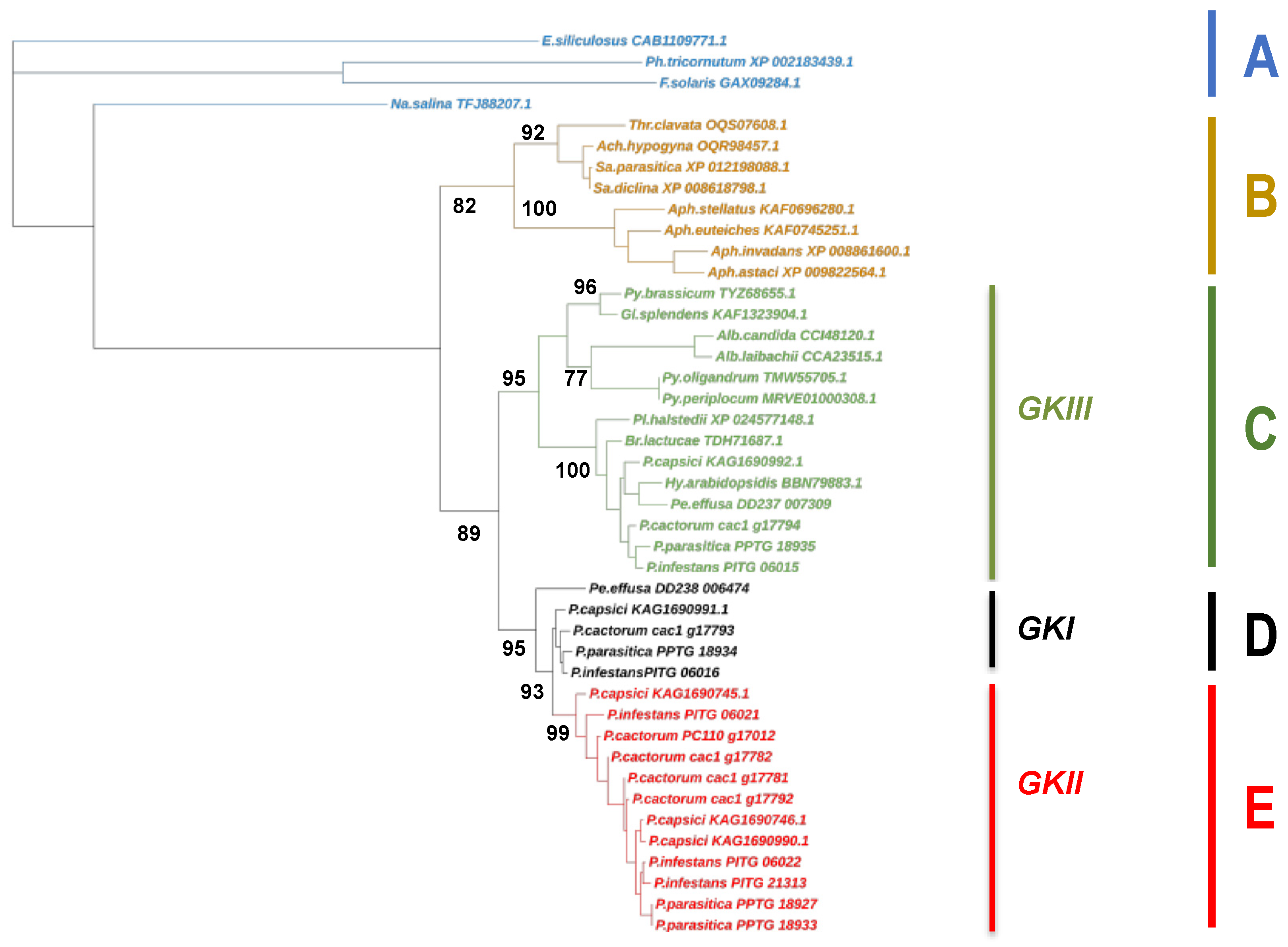
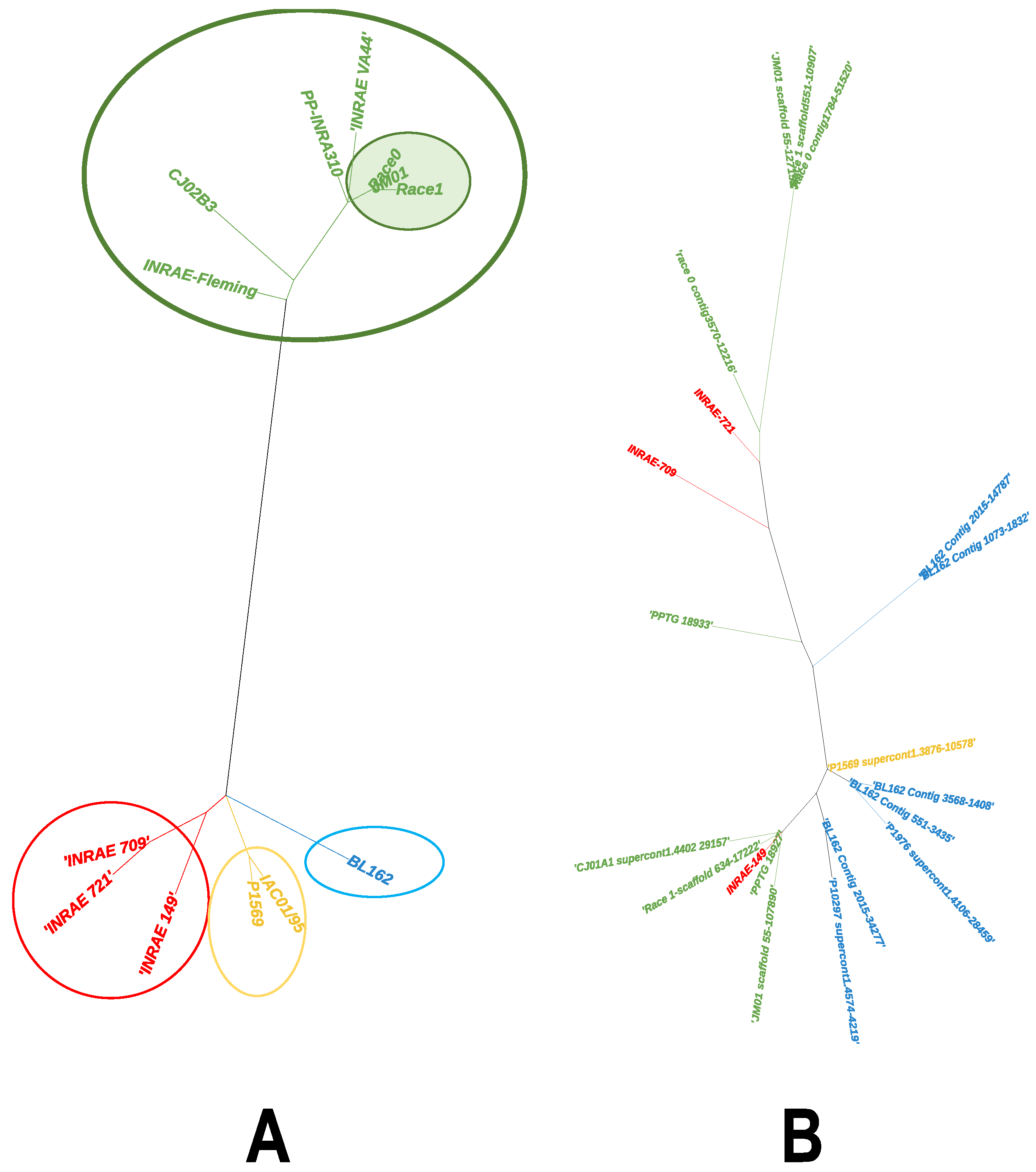
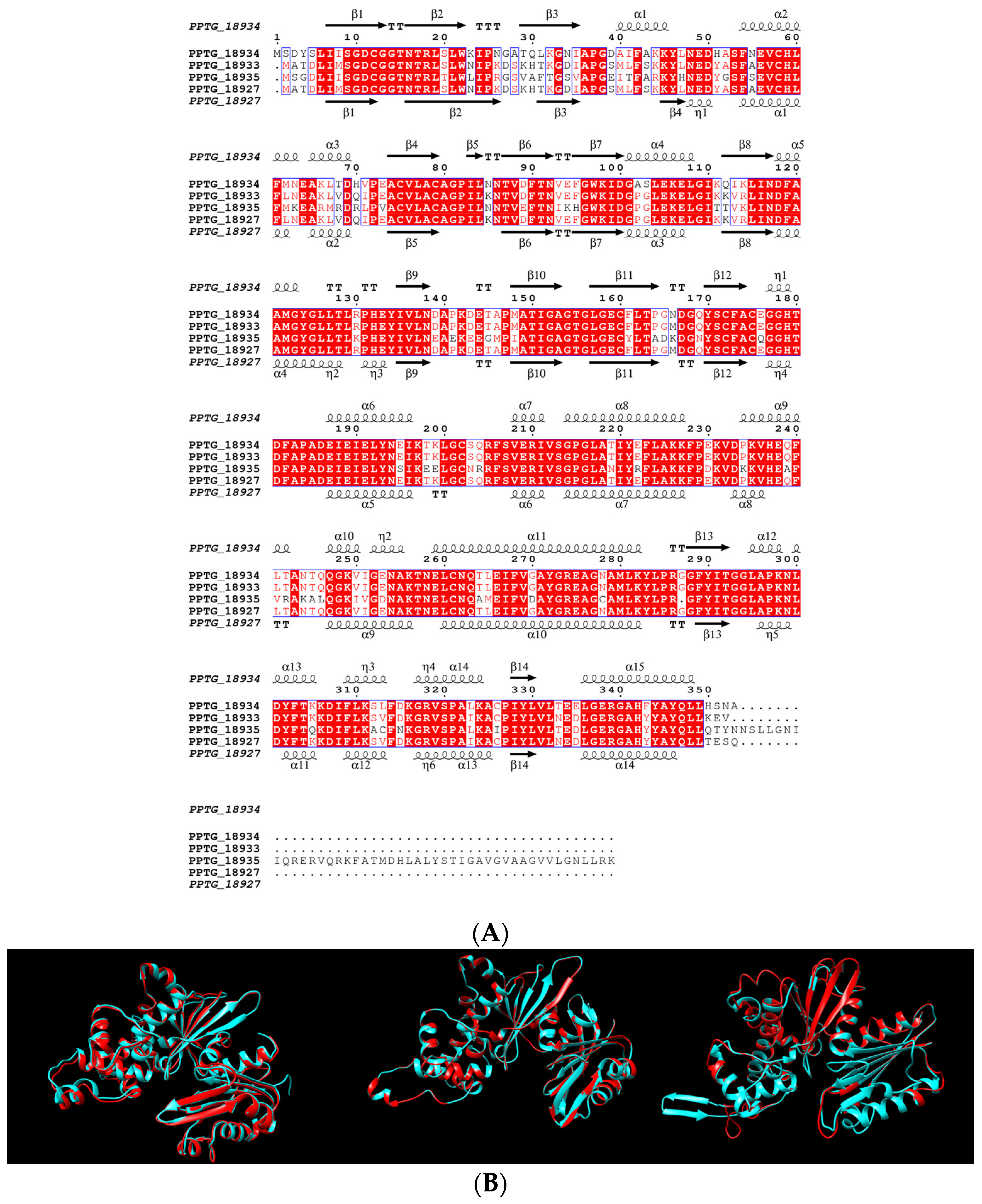
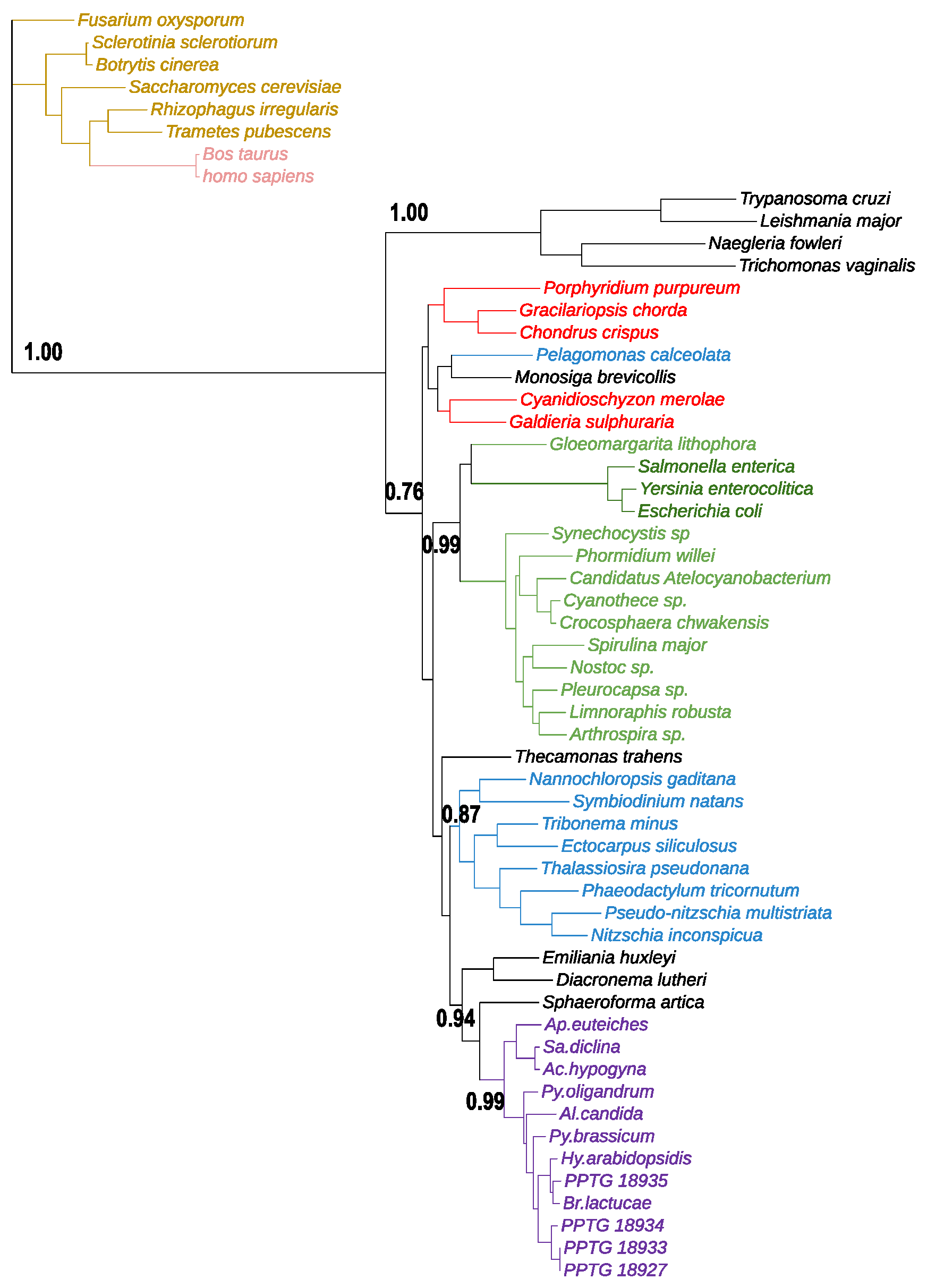
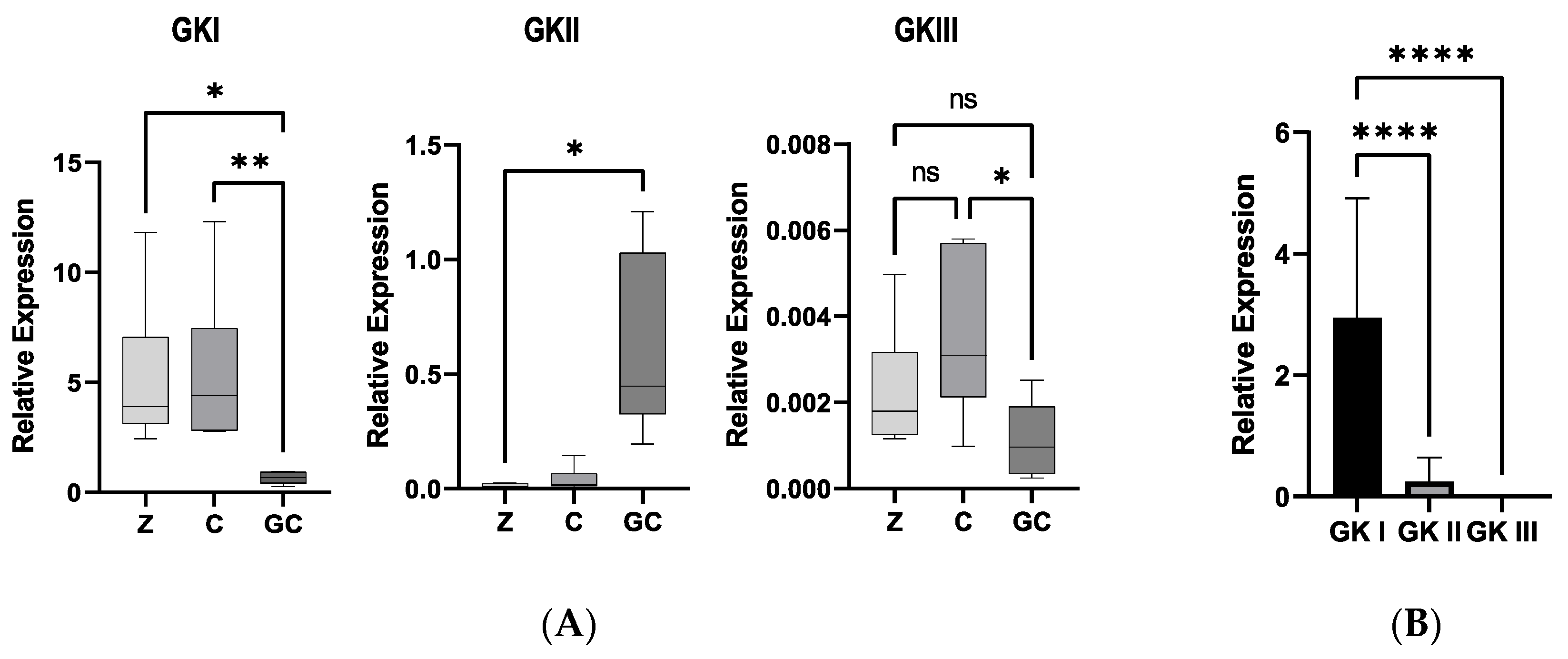
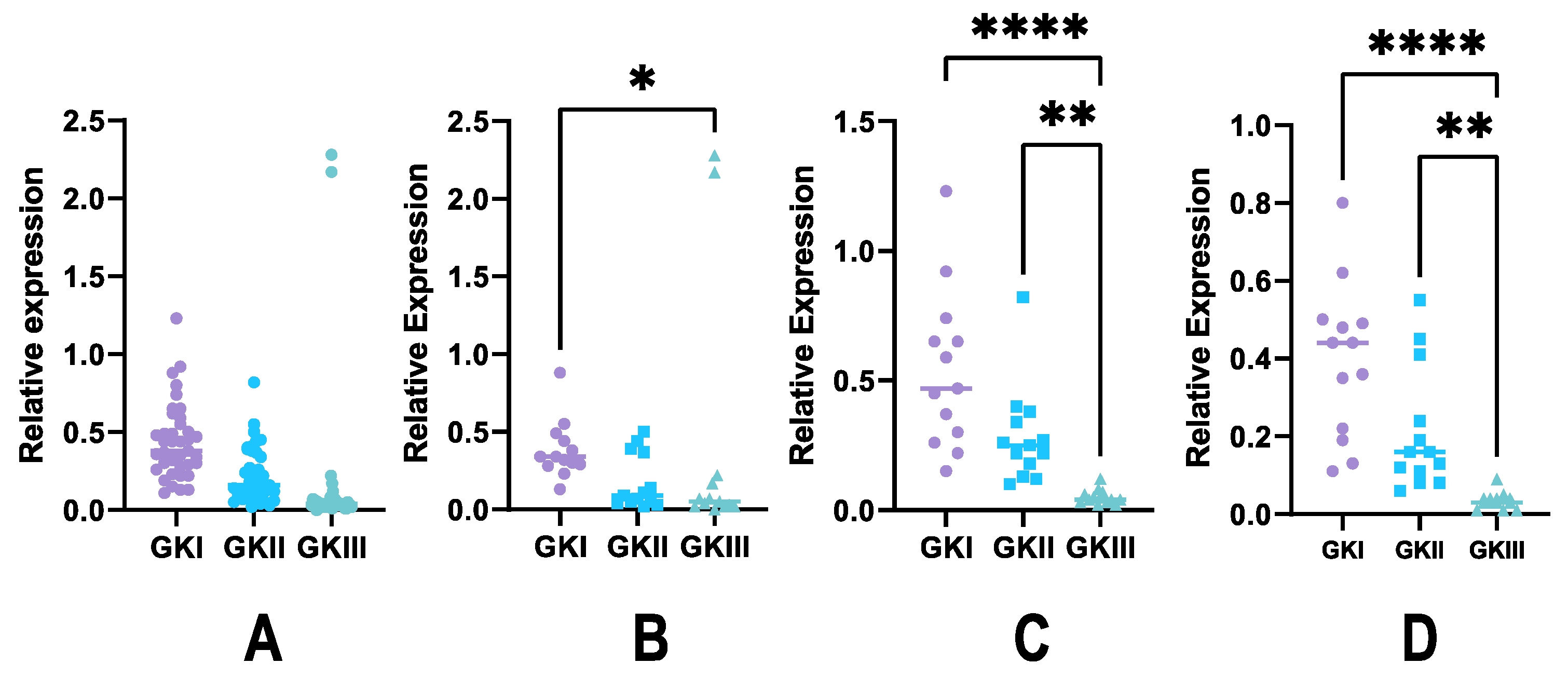
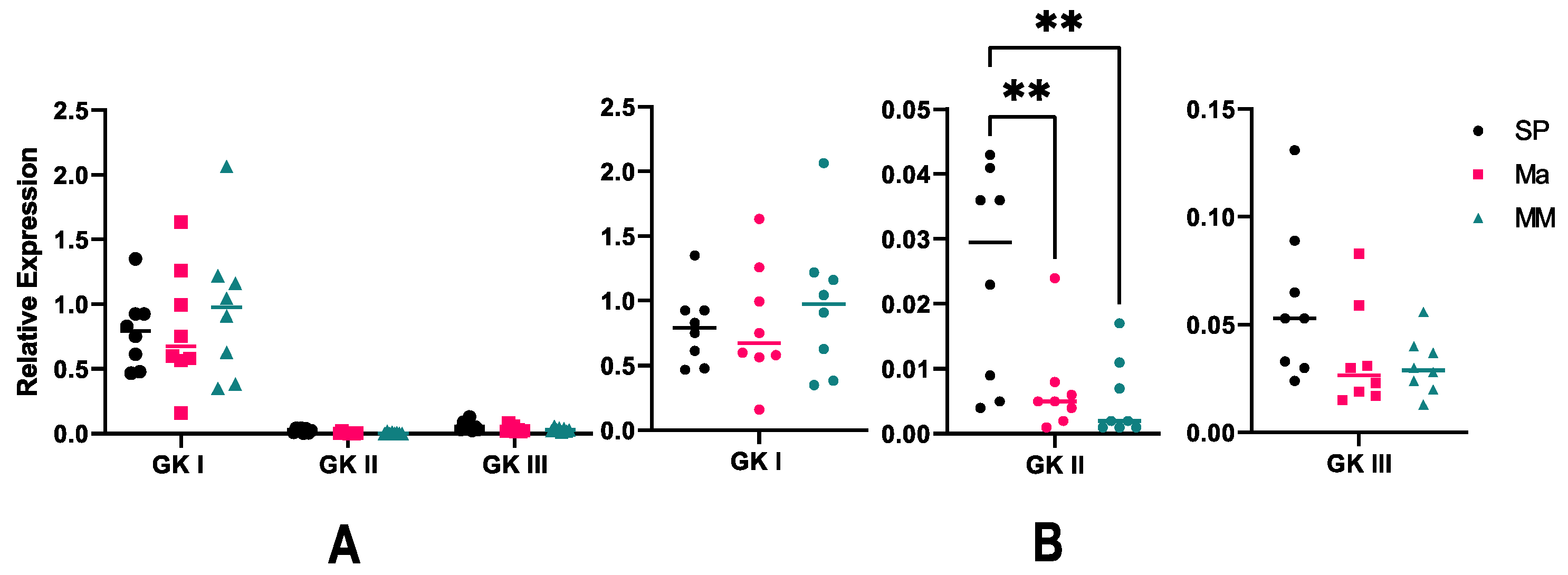
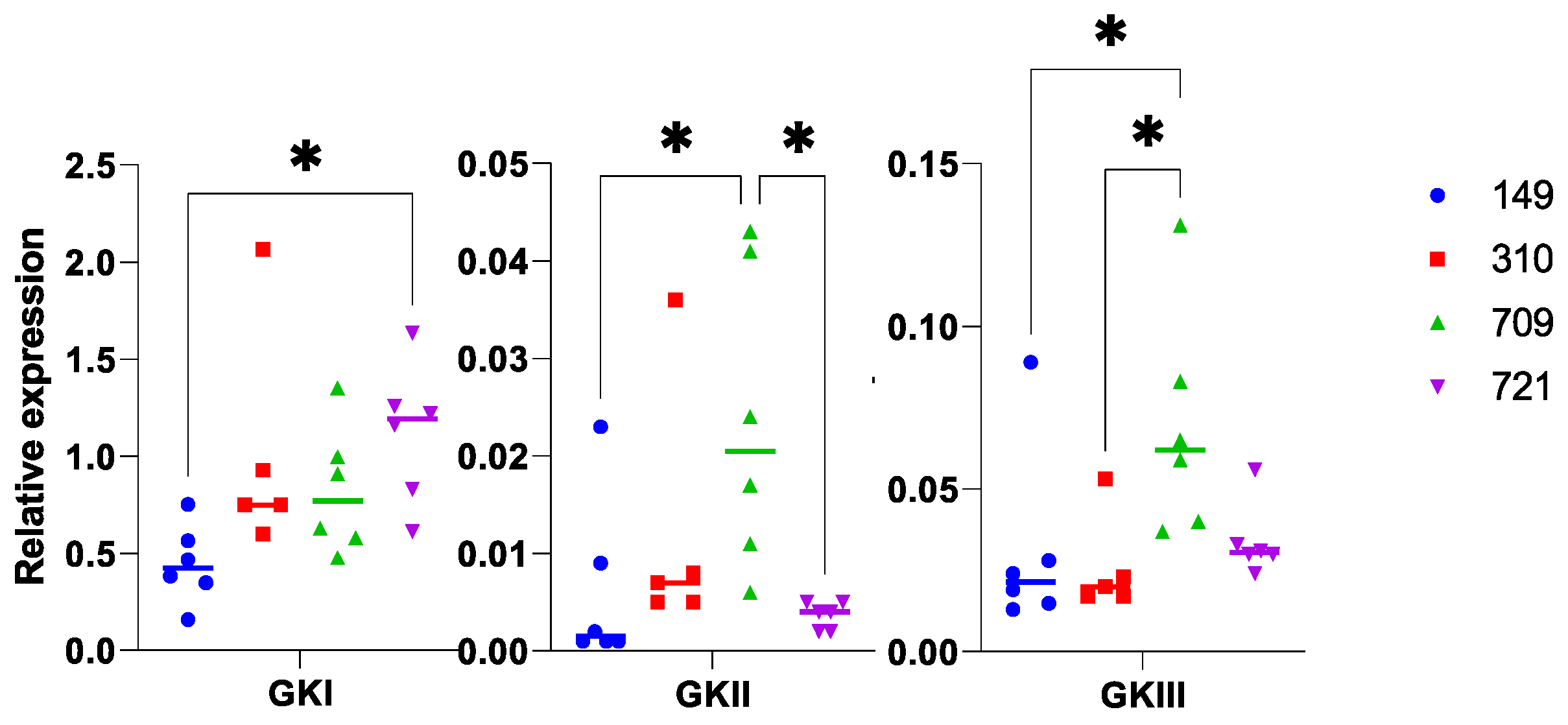
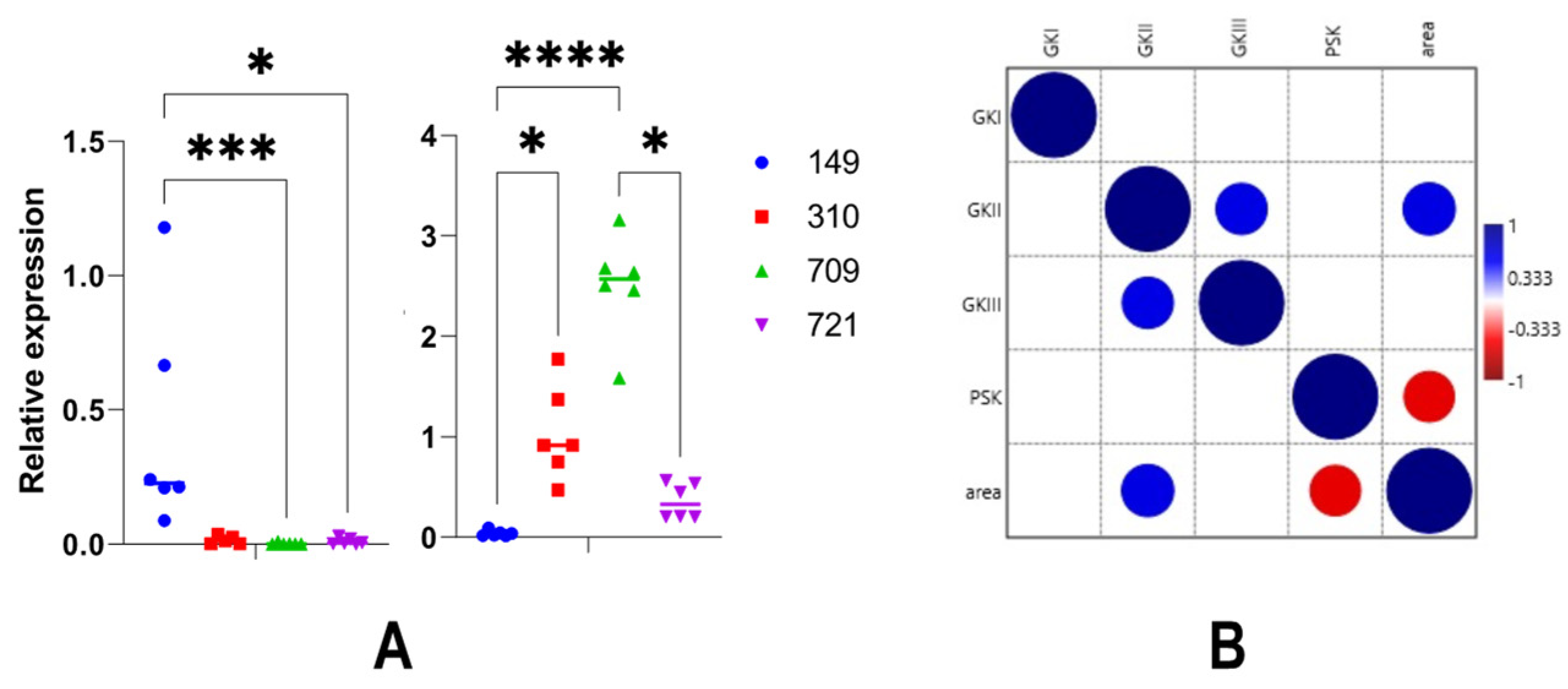
| Relative Activity with Phosphate Donors | |||||||||||||
|---|---|---|---|---|---|---|---|---|---|---|---|---|---|
| Km | Glu | Glu 6-P | Km | Km | |||||||||
| pH | Glucose | Inhibition | Inhibition | Fructose | ATP | ATP | UTP | CTP | GTP | ITP | PPi | ADP | |
| PPTG_18934 | 8.0 1 | 40.5 ± 5 µM | Y | N | NR | 700 ± 50 µM | 100 | 0.4 | 0.81 | 1,2 | 0 | 0 | 0 |
| PPTG_18927 | 7.5 1 | 32 ± 2.5 µM | N | N | NR | 500 ± 50 µM | 100 | 0.32 | 0.77 | 1 | 0.14 | 0 | 0.9 |
| PPTG_18935 | 8.0 2 | 125 ± 25 µM | N | N | NR | 250 ± 25 µM | 100 | 10.4 | 9.5 | 20.5 | 13.6 | 0 | 2.5 |
| PPTG_18886 | 8.5 1 | NR | N | NR | 57.5 ± 5 µM | 1000 ± 50 µM | 100 | 1.6 | 0.75 | 0.3 | 0.8 | 0 | 0 |
Publisher’s Note: MDPI stays neutral with regard to jurisdictional claims in published maps and institutional affiliations. |
© 2022 by the authors. Licensee MDPI, Basel, Switzerland. This article is an open access article distributed under the terms and conditions of the Creative Commons Attribution (CC BY) license (https://creativecommons.org/licenses/by/4.0/).
Share and Cite
Kuhn, M.-L.; Berre, J.-Y.L.; Kebdani-Minet, N.; Panabières, F. Neofunctionalization of Glycolytic Enzymes: An Evolutionary Route to Plant Parasitism in the Oomycete Phytophthora nicotianae. Microorganisms 2022, 10, 281. https://doi.org/10.3390/microorganisms10020281
Kuhn M-L, Berre J-YL, Kebdani-Minet N, Panabières F. Neofunctionalization of Glycolytic Enzymes: An Evolutionary Route to Plant Parasitism in the Oomycete Phytophthora nicotianae. Microorganisms. 2022; 10(2):281. https://doi.org/10.3390/microorganisms10020281
Chicago/Turabian StyleKuhn, Marie-Line, Jo-Yanne Le Berre, Naima Kebdani-Minet, and Franck Panabières. 2022. "Neofunctionalization of Glycolytic Enzymes: An Evolutionary Route to Plant Parasitism in the Oomycete Phytophthora nicotianae" Microorganisms 10, no. 2: 281. https://doi.org/10.3390/microorganisms10020281
APA StyleKuhn, M.-L., Berre, J.-Y. L., Kebdani-Minet, N., & Panabières, F. (2022). Neofunctionalization of Glycolytic Enzymes: An Evolutionary Route to Plant Parasitism in the Oomycete Phytophthora nicotianae. Microorganisms, 10(2), 281. https://doi.org/10.3390/microorganisms10020281






